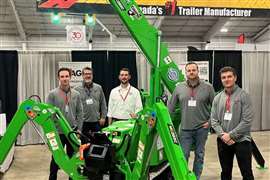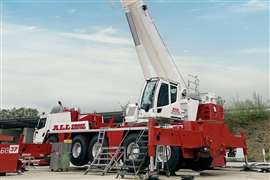Trends and developments in all terrain cranes
18 July 2013

Traditionally it has been typical for all terrain cranes above a certain capacity to have two engines; a large one in the carrier for road travel and another smaller one in the slewing upper structure to power the crane. A growing trend however is to use one engine instead of two.
There are pros and cons to each concept of having a single engine design. Arndt Jahns, product manager, all terrain cranes at Terex, says, “To have only one engine means you optimise space, maintenance and you save costs. Having one engine also overcomes issues from the effect of the Tier 4 Final regulations, where there is less physical space to put the components.”
Further arguments for the one engine design come from crane manufacturer Liebherr, which says that when it comes to replacing an engine, it is easier and cheaper to replace one engine instead of two. In addition, weight saved from removing the second engine can be used to get extra capacity, boom length or counterweight, Liebherr says.
The weight saving potential, however, is challenged in some quarters. Thomas Schramm, general manager at Tadano Faun, says, “When you have a single engine you have to transport energy either through mechanical or hydraulic connections to the point of use. These additional components, such as extra oil coolers, piping and prop shafts, add weight, however they are necessary to transfer the power from the carrier to the upper structure. In addition, these parts will need to be maintained or replaced after some time. So the weight saving to a large extent is cancelled out by these additional components you have to install.”
Additional positives cited for a two engine design approach include lower running costs and less maintenance. “A large, single engine that is operating all the time will require maintenance at a shorter interval compared to two engines, which only run for half the time,” said Schramm. “Secondly, a smaller engine normally uses less fuel compared to a bigger engine. As a rough calculation, a two engine design can save up to 3 litres of fuel power per hour. Multiply this by 1,500 hours and end users can save 4,500 litres per year. With a litre of fuel priced at Euro 1.50, potential savings could be Euro 6,200 per year. Over ten years there is a potential saving of around Euros 60,000.”
New models
The one engine design concept has been adopted by crane manufacture Liebherr on its new 300 tonne capacity LTM 1300-6.2. The new crane, a replacement for the LTM 1250, was introduced at Bauma 2013. Instead of the twin-engine concept normally used on cranes in this class, the LTM 1300-6.2 is powered by a single engine with a mechanical shaft drive for the upper. Wolfgang Beringer, spokesman at Liebherr-Werk Ehingen, explains the design, “Drive shafts are routed from the distributor gear in the substructure via two bevel gears up through the centre of the slewing ring to the hydraulic pump distributor gear in the superstructure. The mechanical shaft ensures a particularly high efficiency. Low engine speeds in the chassis engine provides sufficient power for crane work. This ensures the economy of the new concept in terms of fuel consumption.”
In addition to its one engine design, the LTM 1300-6.2 has a 78 metre telescopic boom and the ECOmode system, which enables the pump drive to be disconnected automatically when the engine is idling (for more information on Ecomode, see page 31 of June 2013 issue of IC).
A single engine concept from Manitowoc is followed in the Grove GMK6400. Astrid Hager-Guthrie, Manitowoc Cranes global product director, all terrain cranes, explains, “Our latest all terrain crane model with the single engine concept is the six-axle GMK6400. It is a 400 tonne machine with a 60 metre main boom and a 79 metre luffing jib.” The GMK6400, shown production ready at Bauma 2013, has the MegaWingLift capacity enhancing attachment. It’s a boom suspension device which can increase load chart capacity from 38 tonne at 60 metres by almost 70 per cent to 64 tonnes at the same height.
Another feature on the crane is the hybrid drive, MegaDrive, a system of normal driven axles on axles 1 and 2 and the addition of hydrostatic drive on axles 4 and 5. The hydrostatic drive is activated at speeds of 20 km/h or lower and allows precise manoeuvring and exact placement in areas with difficult surfaces, a company spokesperson says. Above 20 km/h the conventional mechanically driven axles take over.
Worldwide operation
Terex has also recently introduced a single engine all terrain to the market, the Explorer 5800. The all terrain falls in the middle category of all terrains (230 tonnes capacity) and, according to the manufacturer, because of its one engine design, it addresses a number of problems. The Explorer 5800 is also compliant with many traffic regulations worldwide. It is a prototype and undergoing testing, ready for delivery in the first quarter of 2014.
Crane manufacturer Tadano Faun continues to follow the two engine principle, using Mercedes Benz BlueTec engines. New to the industry with this design is the ATF 180G-5. The all terrain has a capacity of 180 tonnes and a maximum boom length of 60 metres, with an additional extension of 37.2 metres. Power comes from a Mercedes Benz (Euromot III B, EPA Tier 4i) 405 kW (551 PS) and a smaller 129 kW (175 PS) engine in the upper for crane operation. Transport weight is 60 tonnes, with a 12 tonne axle load including 13.2 metre boom extension and 25 tonne hook block.
One of the biggest design advantages of an all terrain is flexibility, being able to drive on public roads and off-road on site. The 3-axle Liebherr 60 tonne LTM 1060-3.1 meets demands for roadability. It has a total weight of 36 tonnes and includes 5.5 tonnes of counterweight, 48 m telescopic boom and 16 m folding jib; hoist heights are up to 63 m and radii is up to 48 m when used with folding jib. “To offer the widest range of driving conditions, in particular at an axle load of 12 tonnes, a special ballast plate configuration has been implemented in the design,” says Beringer. “Depending on the crane equipment and the required vehicle payload, the ballast carried may be 3.7 tonnes, 4.3 tonnes, 4.9 tonnes or 5.5 tonnes.” For countries without the 12 tonne axle load restriction, the LTM 1060-3.1 drives at approximately 15 tonnes per axle with maximum ballast of 12.8 tonnes.
Being able to work in small and restricted spaces on job sites is another factor that manufacturers are taking into consideration. The new Grove GMK3060, for example, has a 43 metre boom on a 3-axle carrier, and has been designed for lifting jobs in tight locations. It is an upgraded version of the GMK3055 and has an additional 2 tonnes of counterweight.
A recent introduction from crane manufacturer XCMG in China is the QAY1200. The 1,200 tonne capacity 9-axle AT crane has a twin engine design and an 8-section telescopic boom. It has 5-axle drive and all-wheel steering. “The QAY1200 can be widely adopted in lifting installation operations in energy, transportation, petrochemical and other major projects,” a spokesperson from XCMG says. In addition, the crane can self-disassemble its boom and counterweight.
Also new from China is the Zoomlion QAY260. More details are yet to be released.
Looking ahead
Looking further ahead in the development of all terrains, crane manufactures are focusing on emissions legislation. “While this process is continuing to demand a lot of engineering hours, we are looking at other new features and will bring these in where it makes sense,” adds Astrid Hager-Guthrie at Manitowoc. In addition, as wind and nuclear power projects continue to be developed, especially in China, it is expected that in the next five years higher-tonnage all terrain cranes will also be developed.
VARIABLE SUPPORTING BASE
Working on sites often means difficult, constricted conditions and it is often not possible to equally extend all the outrigger supports. To overcome this issue, Liebherr has developed a system which enables individual crane supports to be extended to any spread length. This results in safe operation of the crane. The process is part of the Liebherr LICCON control system, and is called the Variable Supporting Base. The system works by measuring the extension length and support force of every support; the control system then calculates the maximum lifting capacities for the situation.
“The system means that for the first time it is possible to work safely with any support base,” says a spokesperson from Liebherr. “Furthermore, accidents caused by incorrect operation can be avoided both during the setup process and when handling loads.”
The Variable Supporting Base ensures higher lifting capacities and a larger working range, even with a maximum support base, the company says. The largest increases are made in the operating ranges directly above the supports. The Variable Supporting Base system also makes improvements over the 360 degrees lifting capacity tables for hoisting to the front and rear.
“When the crane is used with part ballast the increase in lifting capacity and the extension of the radius is even more pronounced with the new system than with full ballast. This means less ballast transport is needed for many crane jobs,” a company spokesperson adds.






